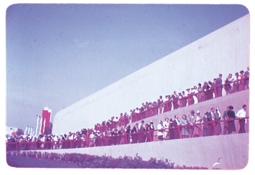A maverick theater and industrial designer, Norman Bel Geddes is best remembered for creating the undisputed hit of the 1939 New York World’s Fair. Mounted in the midst of the Great Depression, the Fair focused on America’s promise of a utopian tomorrow. Geddes’s Futurama, a piece of “immersion theater,” took six hundred visitors at a time on a swooping, simulated airplane ride across America circa 1960. Few people in 1939 had ever ridden in a plane. Looking down, they saw everything from experimental farms and “floating” airports to seven-lane highways, multi-decked bridges, and radio-controlled traffic moving beneath suspended pedestrian walkways—all radical concepts at the time. More than twenty-four million people waited for up to five hours, in rain and hot sun, to experience it. Today, Futurama is considered the most iconic Fair exhibit of all time.
Sponsored by General Motors to the tune of seven million dollars, the equivalent of ninety-one million dollars today, it was the largest animated model ever built: 35,738 square feet. It required the labor of some three thousand carpenters, electricians, draftsmen, and model-makers, and the manufacture of five-hundred thousand miniature buildings varying in scale, two million handmade miniature trees (eighteen different species, with imported moss for foliage), and fifty thousand futuristic silver automobiles—ten thousand of them designed to move. More astonishing still was that the exhibit required complex technological innovations (a twenty-ton sound machine that played 150 individually synchronized loops; a massive conveyor belt that turned corners and changed elevations) that had existed only in theory when, eleven months prior to the Fair’s opening, General Motors jettisoned its previous exhibit plans and gave Geddes the green light.
The City of Tomorrow, a model of Manhattan that Geddes created, in 1937, to promote Shell Oil Company’s new “motor-digestible” gasoline, is often cited as the inspiration for what was to come. But Futurama’s beginnings actually harken back much further, to the meticulous, insanely detailed private games he created in the 1920s and early ’30s for the amusement of his friends.
In esoteric circles, gamester Geddes is acclaimed Manhattan’s greatest. Auction bridge and poker are dismal to him, and so with the fervor and precision of a half-mad mathematician, he creates games colossal in scale, appalling in complexity.
—Time, March 4, 1929
*
One of Geddes’s first small-scale amusements was a five-by-three-foot football field, with players kicking, passing the ball, running, blocking, and tackling. He followed up with a mechanical baseball game. Players pitched the ball, hit it, and ran the bases. More ambitious was an indoor golf game, conjured up years before Garnet Carter’s first Tom Thumb Miniature...
You have reached your article limit
Sign up for a digital subscription and continue reading all new issues, plus our entire archives, for just $1.50/month.
Already a subscriber? Sign in





